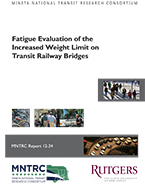Abstract:
The recent increase of freight railcar weight limits from 263,000 lbs. to 286,000 lbs. raises concerns for the safety of bridges on transit passenger rail systems, since they were not designed for this weight increase. Thus, there is a need to assess the impact of the weight increase on those bridges prior to utilizing passenger lines for freight transportation. This study introduces an accurate approach to ascertaining the remaining fatigue life of steel railway bridges. The analysis results indicate that heavy freight cars have a significant effect on critical locations near bridge supports. The introduction of heavier rail equipment will have a much more significant effect on shorter spans (span lengths of less than 60 ft.) than on long spans. This will allow transit operators or agencies to prioritize and schedule repairs and rehabilitation. An increase of 1,000 freight trains per year will shorten the remaining fatigue life by approximately 2 years. The relationship between annual freight train frequency and remaining fatigue life could help transit operators or agencies to balance the tradeoff between economic benefit and bridge rehabilitation cost.
Authors:
HANNI NASSIF, PH.D.
Hani Nassif is a Professor at Rutgers, The State University of New Jersey. He established Rutgers’ Bridge Engineering Program, and is currently working in the research area of Structural Health Monitoring (SHM) and Field Testing of Infrastructure facilities with emphasis on railroad as well as highway bridges. Dr. Nassif is also involved in the development of live load models based on Weigh-In-Motion (WIM) truck weight data with the help of his graduate students, as part of the Doremus Avenue Bridge project, for the estimation of remaining fatigue life based on field measurements and extreme value theory. He has organized several workshops sponsored by Federal and State agencies on the development of specifications for bridge design, construction, and evaluation. Dr. Nassif was also involved in the pioneering work of code calibration for the AASHTO LRFD Bridge Design Specifications (1994) as well as the Ontario Highway Bridge Design Code (OHBDC) and is currently involved in an ongoing NCHRP project for the calibration of AASHTO’s design of concrete bridges at the Serviceability Limit States.
He is a Fellow of the American Concrete Institute (ACI) and member of its Technical Activity Committee (TAC) and serves as the Vice President of the New Jersey ACI Chapter. He is active in TRB’s committees including Committee on General Structures (AFF10). He received various awards including the American Council of Engineering Companies (ACEC) Educator of The Year Award (2006) and American Society of Civil Engineers (ASCE) Central New Jersey’s Educator of The Year Award (2005) for excellence in education and his dedication to student learning. He served as the President of the Rutgers’ Chapter of the Scientific Research Society. He is a member of the Engineering Honor Societies Tau Beta Pi and Chi Epsilon. Dr. Nassif has several years of practical experience in the area of structural design and construction.
Professor Nassif obtained his B.S. and M.E. in Civil Engineering from The University of Detroit in 1981 and 1983, respectively. He received his Ph.D. in Structural Engineering from the Civil and Environmental Engineering Department and a Graduate Certificate in Intelligent Vehicle-Highway Systems (IVHS) from the Electrical Engineering and Computer Science (EECS) Department from the University of Michigan-Ann Arbor in 1993.
KAAN OZBAY, PH.D.
Kaan M.A. Özbay received his B.S. in Civil Engineering in 1988 from Bogazici University, Istanbul, Turkey, his M.S. in 1991 in Civil Engineering (Transportation) from Virginia Tech, and his Ph.D. in Civil Engineering (Transportation) in 1996. Dr. Ozbay’s research interest in transportation covers advanced technology applications in ITS, incident management, development of real-time control techniques for traffic, application of artificial intelligence and operations research techniques in network optimization, and development of simulation models for automated highway systems. Dr. Ozbay joined Rutgers University Department of Civil and Environmental Engineering as an assistant professor in July, 1996. He was promoted to Associate Professor and Professor with tenure in July 2002 and July 2008, respectively.
Dr. Ozbay is the recipient of the prestigious National Science Foundation (NSF) CAREER award. This is a four-year award given to young tenure track faculty that has the highest potential for research and education. Dr. Ozbay has recently co-authored a book titled “Feedback Based Ramp Metering for Intelligent Transportation Systems” which is published by Kluwer Academics in 2004. In addition to this book, he is also the co-author of two books titled “Feedback Control Theory for Dynamic Traffic Assignment”, Springer Verlag and “Incident Management for Intelligent Transportation Systems” published by Artech House publishers in 1999 both with Dr. Pushkin Kachroo of Virginia Tech. Dr. Ozbay published more than 150 refereed papers in scholarly journals and conference proceedings. Professor Ozbay serves as the “Associate Editor” of Networks and Spatial Economic journal and is a member of the editorial board of the ITS journal. He is also a member of the Member of the Scientific Committee of the World Conference on Transportation Research Society (WCTRS) between 2005 and 2007.
PENG LOU
Peng Lou is currently a Ph.D. student in Civil Engineering from Rutgers, the State University of New Jersey. He received his B.S. from Zhejiang University, China in 2010. He received his M.S. from Rutgers, the State University of New Jersey in 2012. His study interests include Structural Health Monitoring (SHM) of bridges, dynamics of bridges, including the bridge-vehicle interaction, and fatigue of bridges.
DAN SU
Dan Su is a Ph.D. student in Civil Engineering from Rutgers, the State University of New Jersey. He received his M.S. from Beijing Jiaotong University in 2008. His study interests include structural reliability and safety, structural deterioration, advanced materials and structural health monitoring.


